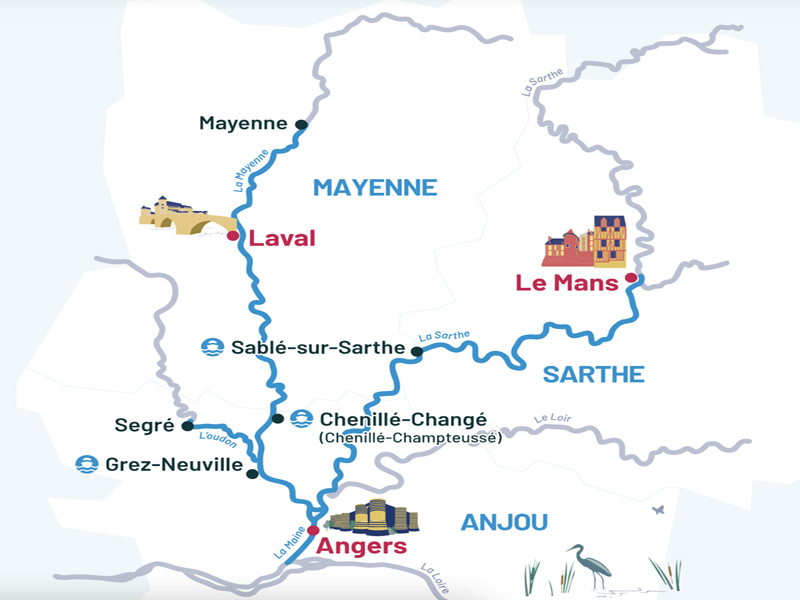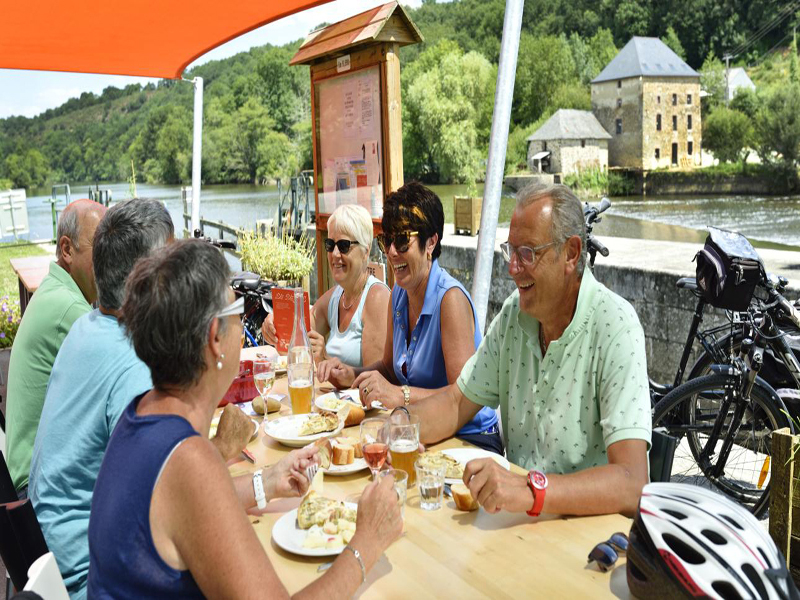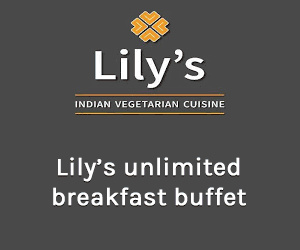Vicky Smith checks out an exciting new river network and one of France’s artiest cities
There is something truly magical about St. Pancras International: its soaring red-brick tower, the Victorian Gothic flourishes, that vaulted glass ceiling that yawns majestically above you.
Most magical of all, though, is that it’s a portal to other countries - granted you can’t travel to Hogwarts, Harry had to go from King’s Cross for that, but you can catch the train to some of Europe’s most beguiling nations. Such were my thoughts as I boarded my first ever Eurostar to France.
I was heading to Pays de la Loire, also known as the Atlantic Loire Valley, less renowned than neighbouring Centre-Val de Loire but all the more enchanting for it. It would be a trip of two halves, ending with a city break in the capital of Nantes and starting with the Rivers of Western France, conceived by tourist boards across three of the region’s five departments. While the rivers themselves obviously aren’t new, this recently created network packages them into a handy website listing places and activities you can enjoy in this watery haven. You’ll also find brochures, again with inspiration and relevant companies, in visitor centres along the route.

So what is river tourism? Well it’s a growing trend in France and simply means using rivers as the backbone of a trip: whether literally sailing between places on a houseboat or following them on land and stopping at key spots along the way. The idea is to mix riverside attractions with water-based recreation for an immersive “slow travel” holiday.
Unfortunately we didn’t go to Sarthe and its famed sporting capital Le Mans on this visit, instead focusing on the river network’s other two departments of Mayenne and Maine-et-Loire (also named Anjou). From the glorious St. Pancras, my companions and I first travelled via Eurostar to Paris and then onward to Laval, capital of Mayenne. With many French hallmarks that tourists love - wonky timbers, cobbled streets, regal mansard roofs - yet few of the crowds, this set the tone for our voyage across a truly underrated region.
Angers, capital of Maine-et-Loire, won me over further - from the UNESCO-listed Apocalypse Tapestries in its château (even if the English are depicted as devilish enemies) to our accommodation in Hôtel d'Anjou: an Art Nouveau-Deco-Gothic fantasy with swirling metalwork, jewelled stained glass and lashings of gold. Lunch in the hotel’s restaurant Odorico, including cannelloni with creamy Gorgonzola and hazelnut emulsion, was another bonus.
But of course river tourism isn’t all about pleasures on terra firma; water-based activities across the Rivers of Western France network include paddleboarding, canoeing, kayaking, waterskiing, wakeboarding and even e-foiling. Boating options abound too, from self-drive barges (rentable for a few hours, a day or longer) to cruises and the “Dandy”.
Admittedly I’m not into most water sports, yet I loved trying out the Dandy boats - as my companion pointed out with a laugh, whizzing about on these electric single-seaters is like being in a James Bond movie, if a bit tamer. It doesn’t harm that they’re rented from a company in Château-Gontier-sur-Mayenne, whose stretch of river is just as scenic as its town centre. After the initial jolting trepidation (thanks to an unexpectedly reactive joystick) I was soon speeding along, accompanied by a sweet tang of wood smoke and swifts pirouetting around me in search of insects.

Back on land, I discovered there’s more than riverside towns and cities to delight. Various walking and cycling routes run through the region - such as Loire à Vélo and La Vélo Francette - while attractions, some a little further from the water, span vineyards and châteaux to venues like Terra Botanica theme park and the Robert Tatin Museum (a personal favourite).
Artisan workshops like knife making at Coutellerie du Maine-Anjou are another staple, as is dining at casual eateries known as “guinguettes”: many converted from lock-keepers’ cottages and situated by pretty locks and weirs filled with birdsong.
My top guinguette experience? Cycling on La Vélo Francette from Laval to Origné and stopping for a long leisurely lunch at L'Écluserie, an old rose-pink house with cream shutters and bees buzzing lazily in pots brimming with flowers. After a board of cheese and sausage (plus, naturally, hunks of bread), we tucked into caramelised pork with veg and noodles followed by rhubarb cake. Simple but oh so satisfying.

Alas, all good things come to an end; after a few days exploring the Rivers of Western France, it was time for the second part of my trip and something completely different - a city break in Nantes, capital of both Loire-Atlantique department and the whole of Pays de la Loire, to which I took a short train ride from Angers.
From a post-industrial cultural backwater in the 1980s to one of France’s artiest cities today, Nantes has undergone a spectacular transformation in recent decades. One of its biggest calling cards is public artworks, many connected by a green line that stretches over 12 miles from ocean to estuary to vineyards and throughout the city centre; this is added to annually during the Le Voyage à Nantes summer festival. Other initiatives include quirky shop signs and even artist-designed hotel rooms.
Nantes’ eclectic jigsaw of neighbourhoods is the ideal backdrop for this arty adventure, which unfolds in a comic strip of city life. Families sharing a meal in one of Bouffay’s medieval-looking bistros, which casts pools of light onto the narrow cobbles. The whiff of hot sugary dough from a tiny hole-in-the-wall. People queuing outside a patisserie on one of Graslin’s elegant 18th-century streets. The pulsating thrum of bars come evening, peals of laughter and the clink of glass. Friends sipping coffee under cafe parasols amid the vast granite and limestone facades of Feydeau.
Indeed, one of my favourite pastimes in Nantes was simply strolling through its streets. Looking up I’d often catch traces of a decades-old shop sign, like an old fromagerie with a pastoral vignette, or the flutter of bunting and tumble of flowers from a balcony planter. Beyond the green line, I also glimpsed snatches of “unofficial” street art - a cat’s eye, a woman dancing - and was charmed by the melange of boutiques, delis and galleries.
But of course it wasn’t all just meandering. I visited sites like Nantes’ art museum, its 15th-century château and the ornate Passage Pommeraye. I devoured monkfish with taglioni and clams (plus a particularly indulgent plate of profiteroles) in the former fishing village of Trentemoult, with its brightly painted houses and hooks where fishermen once dried produce. I had a peek at the up-and-coming district Chanteney, planned home of a massive new museum on Nantes-born writer Jules Verne - famed for stories such as Around the World in Eighty Days. I learned about Nantes’ citrusy Muscadet wine, took a cruise on the offbeat estuary art trail to Saint-Nazaire and did plenty more besides.
My highlight, though, was a visit to Île de Nantes to see Les Machines de l'Île: a menagerie of mechanical animals headed by its gigantic elephant. This engineering marvel took 150 people 30 months to build (even the leather on its ears took five cows each) and now takes tourists on short daily rides around the complex, which was once used for ship construction. Elsewhere you’ll find other kinetic creatures in a plant-filled gallery space, and a marine-themed carousel whose rides span giant squid to manta rays. The whole thing is a steampunk-fantasy wonderland, and not to be missed.
Talking of invention, there are few more obvious examples of Nantes’ reinvention than Île de Nantes. Once an industrial hub crammed full of factories, it’s fast becoming a hip area filled with culture and forward thinking. There are trendy food halls (one with its own veg garden featuring enormous mismatched wellies), cool geometric buildings by revered architects and a gallery in what was once a hangar for storing bananas. You’ll also encounter lots of green-line installations, including a moonscape children’s playground. As with wider Nantes, I was continually surprised by creativity that defies convention.
In many ways it had been a trip of two distinct halves. Yet, as I realised on my easyJet plane home (a far cry from the romance of Eurostar), the two shared a common thread. While the Rivers of Western France encourages a different form of tourism, knitting together places and activities you might not even have considered, post-industrial Nantes has transformed itself into a true artistic pioneer - both have created something special by thinking outside the box.
Main image: Vicky Smith
Fact file
Vicky travelled by Eurostar to Paris and onward by Ouigo to Laval. She returned from Nantes with easyJet.
She stayed at Parc Hôtel & Spa in Château-Gontier-sur-Mayenne, Hôtel d'Anjou in Angers and Hôtel de France in Nantes.
For more information, visit the tourist websites for Pays de la Loire, Rivers of Western France and Nantes. And for wider France inspiration, head to france.fr.






